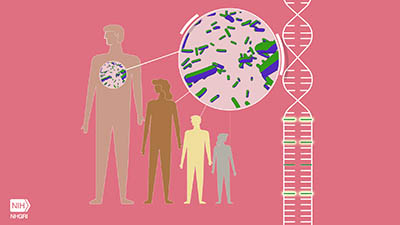Resistance to the Plague May Be a Double-Edged Sword
The Bubonic Plague Has Made Its Evolutionary Mark on the Human Genome
Evolutionary pressure to survive the bubonic plague may have selected for genetic mutations that protect certain Mediterranean populations from being infected by the infamous Yersinia pestis, the bacterium behind the plague. But evolution isn’t perfect. Being able to survive the plague may also be the reason for today’s prevalence of another ancient disease—familial Mediterranean fever (FMF)—National Human Genome Research Institute (NHGRI) researchers recently reported in Nature Immunology (Nat Immunol 21:857–886, 2020).

Dan Kastner was a co-author of a study that found that genomic variants that cause familial Mediterranean fever may also confer increased resilience to the plague.
FMF, an autoinflammatory disease that mainly affects people of Mediterranean and Middle Eastern descent, is caused by mutations in the MEFV gene. The gene encodes pyrin, a protein involved in the inflammatory response. In healthy people, pyrin helps immune cells fight infection by increasing inflammation and producing inflammation-related molecules. In FMF patients, though, pyrin is activated without being triggered by an infection and can cause episodes of hyperinflammation: fever, chest pain, arthritis, and abdominal pain so bad it can be mistaken for appendicitis. Without treatment, FMF can lead to renal failure and death. People with two copies of the mutated MEFV gene are predisposed to FMF; those with only one copy of the mutated gene may develop FMF, but at a lower frequency.
But it turns out that having one or two copies of the mutated MEFV gene may be a secret weapon against the bubonic plague. Normally Y. pestis represses the function of pyrin in healthy individuals and in so doing suppresses the body’s inflammatory response to the plague. But the mutated MEFV genes prevent the ability of Y. pestis to interfere with the normal function of pyrin.
NHGRI Scientific Director Dan Kastner, a senior author on the paper, has studied FMF since 1985 when, as an NIH rheumatology fellow, he treated an Armenian patient who had the disease. Kastner’s group first considered that natural selection played a role in today’s prevalence of FMF because of its unusually high carrier frequency (proportion of people in a population who have only one copy of a mutant gene). The carrier frequency of MEFV mutations in Mediterranean populations is about 10%.
“It wasn’t just a high carrier frequency in one population,” said Kastner. “It was in Jewish populations, Arab, Turkish, [and] Armenian. It didn’t seem like something that would happen just by chance.” If chance were the only factor involved, the carrier frequency would be much lower.

CREDIT: ERNESTO DEL AGUILA III, NHGRI
An illustration depicting specific genomic variants passed down to succeeding generations.
To provide evidence for natural selection, the researchers analyzed the genomes of 2,313 Turkish people and 352 ancient archeological samples including 261 from before the Christian era. Kastner’s team used mathematical modeling to estimate that two FMF-causing mutations in the MEFV gene arose more than 2,000 years ago. They also found that people with the same mutations had stretches of identical DNA flanking the mutation site. This set of DNA variants tends to be inherited together and is called a haplotype. According to evolutionary theory, if there is a selective pressure such as an infectious disease, a haplotype with mutations that protect humans in some way is conserved over the course of multiple generations. But if there is no selective pressure, the haplotype is no longer useful and is lost over time. In people with the normal MEFV gene, the researchers didn’t find a conserved haplotype.
But this evaluation was only evidence that natural selection was increasing the frequency of MEFV mutations in Mediterranean populations. The authors still had to figure out what was causing the natural selection.
Kastner’s group suspected Y. pestis as exerting a potential selective pressure on mutations in the pyrin gene because 1) Y. pestis releases a toxin called YopM that inactivates pyrin—it makes sense that humans would evolve a mutation in the pyrin gene that increases its resistance to YopM; 2) Y. pestis was an incredibly strong selective pressure—the bubonic plague wiped out a third of Europe’s population in the 14th century; and 3) Y. pestis has been able to shape the human genome for an incredibly long time—it was around during the 6th century Justinian plague and the 14th century Black Death.
The researchers found that, compared with cells from healthy control subjects, the immune cells isolated from the blood of people with FMF produced more interleukin 1-beta (an inflammation-causing protein) in response to Y. pestis infection. In addition, immune cells from people with only one copy of the mutated MEFV gene (and who usually do not develop FMF) were also resistant to Y. pestis infection. Even mice that were genetically altered to have two mutated MEFV genes had a clear survival advantage when infected with Y. pestis.
The findings demonstrate the double-edged sword that is evolution. “This is certainly not the first example of a mutation in a recessive disease gene being protective against an infectious agent…on the one hand…but on the other hand causing a human disease,” said Kastner.
Another example of a genetic mutation that is protective yet causes disease is the beta-globin gene, which when mutated causes sickle-cell anemia but also confers resistance to malaria.
Still, evolution has done what is best for humans. Despite a small number of people having two mutant MEFV copies and developing FMF, more have only one copy and are resistant to the bubonic plague.
Moving forward, Kastner plans to consider how interactions between hosts and microbes influence the evolution of other genetic diseases. “The host is just half of the equation, and there’s this whole other world, the microbial world,” said Kastner. “That’s the other half of the overall picture.”

Ethan Smith is a postbaccalaureate fellow in the National Institute of Nursing Research. He is working on clinical studies involving biomarkers for traumatic brain injury. When he completes his training in 2021, he expects to attend graduate school for social work. Outside of work he enjoys playing board games with friends, reading, and watching television.
This page was last updated on Monday, March 21, 2022
